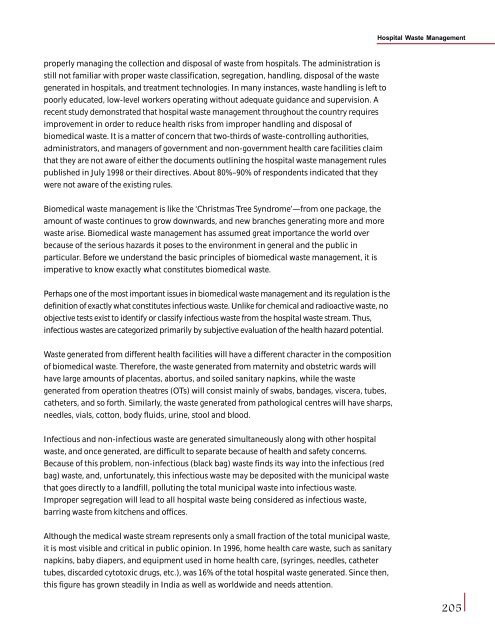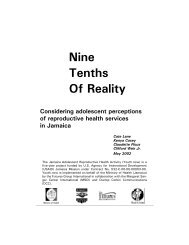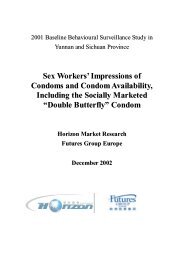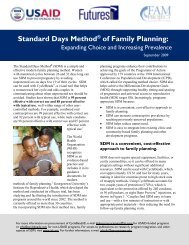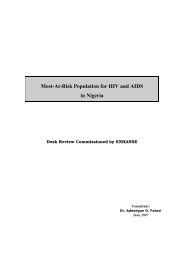Health Policy Issues and Health Programmes in ... - Amazon S3
Health Policy Issues and Health Programmes in ... - Amazon S3
Health Policy Issues and Health Programmes in ... - Amazon S3
- No tags were found...
You also want an ePaper? Increase the reach of your titles
YUMPU automatically turns print PDFs into web optimized ePapers that Google loves.
Hospital Waste Managementproperly manag<strong>in</strong>g the collection <strong>and</strong> disposal of waste from hospitals. The adm<strong>in</strong>istration isstill not familiar with proper waste classification, segregation, h<strong>and</strong>l<strong>in</strong>g, disposal of the wastegenerated <strong>in</strong> hospitals, <strong>and</strong> treatment technologies. In many <strong>in</strong>stances, waste h<strong>and</strong>l<strong>in</strong>g is left topoorly educated, low-level workers operat<strong>in</strong>g without adequate guidance <strong>and</strong> supervision. Arecent study demonstrated that hospital waste management throughout the country requiresimprovement <strong>in</strong> order to reduce health risks from improper h<strong>and</strong>l<strong>in</strong>g <strong>and</strong> disposal ofbiomedical waste. It is a matter of concern that two-thirds of waste-controll<strong>in</strong>g authorities,adm<strong>in</strong>istrators, <strong>and</strong> managers of government <strong>and</strong> non-government health care facilities claimthat they are not aware of either the documents outl<strong>in</strong><strong>in</strong>g the hospital waste management rulespublished <strong>in</strong> July 1998 or their directives. About 80%–90% of respondents <strong>in</strong>dicated that theywere not aware of the exist<strong>in</strong>g rules.Biomedical waste management is like the ‘Christmas Tree Syndrome’—from one package, theamount of waste cont<strong>in</strong>ues to grow downwards, <strong>and</strong> new branches generat<strong>in</strong>g more <strong>and</strong> morewaste arise. Biomedical waste management has assumed great importance the world overbecause of the serious hazards it poses to the environment <strong>in</strong> general <strong>and</strong> the public <strong>in</strong>particular. Before we underst<strong>and</strong> the basic pr<strong>in</strong>ciples of biomedical waste management, it isimperative to know exactly what constitutes biomedical waste.Perhaps one of the most important issues <strong>in</strong> biomedical waste management <strong>and</strong> its regulation is thedef<strong>in</strong>ition of exactly what constitutes <strong>in</strong>fectious waste. Unlike for chemical <strong>and</strong> radioactive waste, noobjective tests exist to identify or classify <strong>in</strong>fectious waste from the hospital waste stream. Thus,<strong>in</strong>fectious wastes are categorized primarily by subjective evaluation of the health hazard potential.Waste generated from different health facilities will have a different character <strong>in</strong> the compositionof biomedical waste. Therefore, the waste generated from maternity <strong>and</strong> obstetric wards willhave large amounts of placentas, abortus, <strong>and</strong> soiled sanitary napk<strong>in</strong>s, while the wastegenerated from operation theatres (OTs) will consist ma<strong>in</strong>ly of swabs, b<strong>and</strong>ages, viscera, tubes,catheters, <strong>and</strong> so forth. Similarly, the waste generated from pathological centres will have sharps,needles, vials, cotton, body fluids, ur<strong>in</strong>e, stool <strong>and</strong> blood.Infectious <strong>and</strong> non-<strong>in</strong>fectious waste are generated simultaneously along with other hospitalwaste, <strong>and</strong> once generated, are difficult to separate because of health <strong>and</strong> safety concerns.Because of this problem, non-<strong>in</strong>fectious (black bag) waste f<strong>in</strong>ds its way <strong>in</strong>to the <strong>in</strong>fectious (redbag) waste, <strong>and</strong>, unfortunately, this <strong>in</strong>fectious waste may be deposited with the municipal wastethat goes directly to a l<strong>and</strong>fill, pollut<strong>in</strong>g the total municipal waste <strong>in</strong>to <strong>in</strong>fectious waste.Improper segregation will lead to all hospital waste be<strong>in</strong>g considered as <strong>in</strong>fectious waste,barr<strong>in</strong>g waste from kitchens <strong>and</strong> offices.Although the medical waste stream represents only a small fraction of the total municipal waste,it is most visible <strong>and</strong> critical <strong>in</strong> public op<strong>in</strong>ion. In 1996, home health care waste, such as sanitarynapk<strong>in</strong>s, baby diapers, <strong>and</strong> equipment used <strong>in</strong> home health care, (syr<strong>in</strong>ges, needles, cathetertubes, discarded cytotoxic drugs, etc.), was 16% of the total hospital waste generated. S<strong>in</strong>ce then,this figure has grown steadily <strong>in</strong> India as well as worldwide <strong>and</strong> needs attention.205


